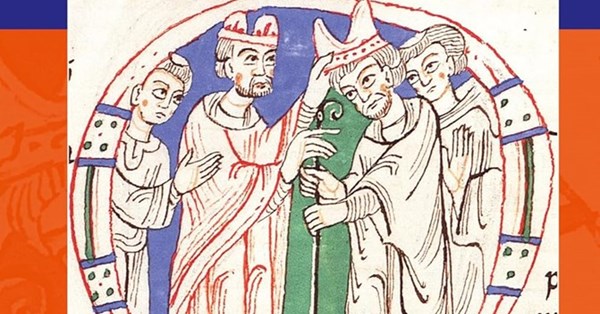THIS repetitious volume studies the development (mid-11th to early 13th century) of the mitre as distinctive headgear for senior clerics and, initially, nobility including two Bohemian dukes. The earliest literary evidence comes from Italy, England, and France: Peter Damian (1062), Goscelin (c.1091), and Hugo of Flavigny (1097-1100).
Nancy Spies has considered 534 images from illuminated manuscripts, stained glass, reliquaries, frescoes, coins, and bracteates (flat metal plaques), as well as tapestries and carving (ivory, wood, and stone). Useful appendices list them, but lack direct links for the many omitted images.
Some are reproduced in thumbnail figures or in line drawings, many unnecessarily repeated: a bishop from an Exultet roll in the Vatican, Gotfredus, and St Ambrose each appear four times. In the “Where’s Willie?” stakes, I gave up counting Tedaldo of Canossa after his fifth appearance; a reproduction of the relevant page in the Vita Matildis (Vatican Apostolic Library, Cod. Lat. 4922, fo.21v.) would be instructive.
She suggests that the origin for wearing the mitre after ten centuries of bare-headed clergy might lie in the Investiture Controversy between the Papacy and the Emperor (my hat is bigger than yours), and asserts that the contemporary introduction of chess influenced the shape of the headgear, deriving from the Arabic chess pieces of the rook (rukh) and elephant.
The first recorded papal grant of a mitre was that given by Leo IX (12 March 1049) to the Archbishop of Trier in his first month as pope. Of the 11 reported grants of mitres 1049-95, six were given to abbots, the first to Egelsino (Æthelsige) of Canterbury. But the lists at pages 111 and 154 vary; is it Reinbert or Udone of Trier? (Udo was Archbishop of Trier 1066-78.) Guarin(o) comes from Aversa, not Averso, in Southern Italy. Take your pick; the text on page 154 claims only five. A copy editor might have spared us Groundhog Day.
Spies traces the development of the mitre in two distinct forms: one a lobed hat, the other the more familiar two-horned that continues in clergy use to this day. For reasons of her own, she wants to dispense with “horns”, and introduces “peaks” to describe them. She also wants to rename lappets pendants (or “pendent”, page 316).
What she knows of ecclesiastical dress is never clear. She mistranslates “tunicella” as dalmatic, and the glossary states “Pontificalia Specific vestments and items that were associated only [my emphasis] with a bishop: mitre, buskins/stockings, sandals, gloves, tunicle, dalmatic, ring, and staff”. Subdeacons, deacons, and priests and the staff of Watts & Co. might beg to differ. His chasuble (“a hooded garment”) appears to be missing.
We might be doubtful that the English “bishop” derives from Old Norse biskup, as both derive from the Latin form of the Greek episcopos. Mitra in the Greek can mean a turban, which might explain the 12th-century practice of the Roman Pontifical when, after the consecration of the bishop and the anointing of his head, “the linen cloths by which until now his head has been bound” were removed and a mitre was placed on his head.
Might the intriguing parchment mitre reportedly worn by the Latin Bishop of Acre in the Kingdom of Jerusalem, Jacques de Vitry, have been an earlier confusion for that worked in opus Anglicanum depicting the martyrdom of Becket (Namur)? That highlight of the 2016 V&A exhibition of English medieval embroidery (Arts, 21 October 2016) is worth more than much of this untidy book.
Canon Nicholas Cranfield is the Vicar of All Saints’, Blackheath, in south London.
The Mitre: Its origins and early development
Nancy Spies
Brill £126*
(978-90-04-69104-9)
*available at brill.com















